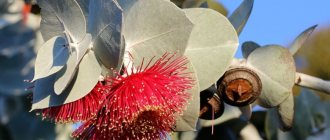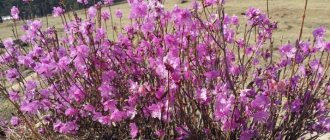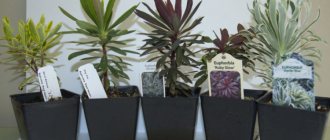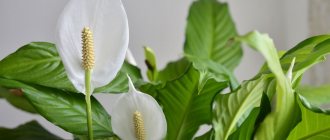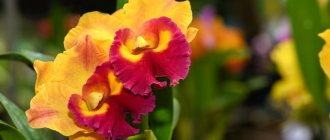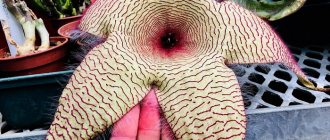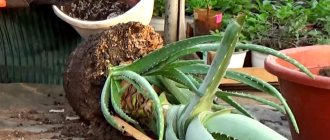Author: Elena N. https://floristics.info/ru/index.php?option=com_contact&view=contact&id=19 Category: Garden plants Published: April 08, 2019Last edits: January 13, 2021
- Wolfsbane
Aconite (lat. Aconitum), or fighter , belongs to the genus of herbaceous perennials of the Ranunculaceae family, representatives of which grow mainly in North America, Asia and Europe. Currently, more than 300 plants of the genus have been described. Aconite is cultivated for decorative and medicinal purposes. You will learn about the history and properties of the wrestler, how to grow it and how to care for it in this article.
Botanical description
Flower growers classify aconite as a member of the Buttercup family. The plant is an erect, bush-shaped plant. In its natural environment, the height of the plant can reach three meters. The flower has a large, developed rhizome, with developed thin brown cords. Up to 15 roots appear on one plant at once, thanks to which the bush grows quickly and is quite unpretentious. This structure of the roots helps to keep the bush firmly on the ground in an erect form.
Among the people, the plant has a large number of names - fighter, wolf root, black potion, slipper.
Thick, light green stems emerge from the base of the rhizome in spring. The stem is dense, narrowed towards the apex. Dense petioles with shoots and leaves extend across the entire surface of the stem. The leaf blade of aconite is palmate. The leaves are large, which gives the plant additional decorativeness. The foliage on the plant is arranged alternately. The leaf blade is dark green, flat, and reaches 15 cm in diameter. Cuts on the foliage give the shrub an unusual appearance.
The plant blooms in large inflorescences. Flowering begins in July; the flowers remain on the plant almost until frost. The decorative nature of the flowers lies in their irregular shape. Various varieties may bloom with white, blue or yellow buds, but most bloom with purple buds. The flowering of aconite strongly resembles the inflorescences of lupines - the flowers are located at the top of the shoots, collected in several pieces.
After flowering, seed boxes are formed in place of the buds. The seeds ripen by mid-autumn. The seeds are quite small, brown or black in color.
Young plants are poisonous, but as they grow, aconite loses its poisoning ability, since the chemical element is removed from the foliage and stems.
Types of aconite
About fifty species of Aconite grow in Russia. They are divided into three subspecies.
- The first contains the most poisonous varieties. They have blue flowers and more than two tubers.
- The second category includes less dangerous plants: purple, yellow, white aconite.
- The third group contains non-poisonous yellow aconites.
Aconite is a fighter that is not picky about lighting and soil. The aconite plant is resistant to cold weather and enjoys almost any feeding. The soil should be mulched with peat about three times a season. It grows for about five years without transplanting.
Djungarian aconite
It is found in the mountains, where moist soil predominates, near the shores of mountain reservoirs. Feels comfortable in forest, subalpine and alpine zones above the sea.
Djungarian aconite has a horizontal rhizome, where cone-shaped tubers grow together in a chain.
- The plant has a dense stem that can reach 130 centimeters in height.
- The plant has a heart-shaped leaf with rounded edges. Extended wide. It is divided into five sectors, each of which is divided into another 2-3 segments.
- The flowers are collected in an inflorescence, where the sepals on top are bent in an arc in the shape of a helmet. About forty stamens, three pistils.
- The fruit is considered to be the trefoil. It happens that only one leaflet ripens. The seed is about 5 mm long. Ripen in late summer, early autumn. Tubers are used in medicine.
Karakol wrestler
This aconite is similar to the previous species. There is a version that Karakol is a variety of Djungarian aconite. Different plant heights. The second reaches two meters. And the leaf sectors are narrower. The flower is not as large as its counterpart. But the color is bright purple.
Often these species grow intermixed. If you come across a mixture of aconites, you will hardly be able to tell the differences. Karakolsky lives comfortably in meadows and near rivers.
Propagated by seeds and rhizomes. Young aconites have one stem. The number increases with age. They all come from the same root. Maximum 4 pieces. Each one has about six dozen seeds.
Wrestler yellow
- Aconite is a perennial herb. A tough root similar to a turnip.
- The leaves protrude in different directions, diamond-shaped, with a ribbed edge.
- The inflorescence is fluffy, but small.
- Sepals in the form of petals. The top one looks like a bell. Aconite climbing. Eight petals, the top pair are curled.
- Aconite is white and yellow in shades. The middle often has a blue tint. Aconite seeds have a triangular and wrinkled texture. Flowering from the second summer month until the beginning of autumn.
Found in forests and near bushes. There are many representatives of yellow aconite in the mountains of Central Europe and Siberia. This is a poisonous variety of flower.
The root is used to poison dangerous animals for protection. Its properties are similar to blue aconite.
Wolfsbane blue
Can be seen in groves and gardens. Often grows along the fence. Perennial and herbaceous species.
- The stem is straight, almost one and a half meters high.
- The leaf of blue aconite is smooth. Green on top, white on the back. It is shaped like a wedge.
- The multicapital root of aconite, 3 centimeters thick, is hidden deep underground.
- Despite the name, the flowers are not only blue. There is white and purple aconite. The structure is the same as yellow.
- The fruit has three leaflets. The seed is dark brown, triangular.
- Blooms throughout the summer season. Its leaves taste bitter. After a while, a burning sensation covers the tongue and palate.
Attention! Blue aconite is poisonous. If you rub the leaf, the smell will make you dizzy. Do not apply to the body, otherwise blisters and wounds will appear.
Northern or tall wrestler
Like the previous species, it is a perennial grass.
- In the flowering phase, the fighter older than two years has a vertical root with thin appendages.
- The stem is straight, two meters long.
- Ribbed to the touch, drooping with leaf petioles and pedicels.
- The leaves are round, closer to heart-shaped, dense. Dissected into diamond-shaped sectors. Some are covered with barely noticeable small hairs.
- The inflorescence is long, almost half a meter. At the same time rare.
- The flowers of aconite are purple and dirty in color. The center is almost white.
The northern fighter loves moist soil and freshness. Found in forests, meadows, coastal areas of rivers and mountains.
Aconite bicolor
A two-colored species of aconite plant. The inflorescences are tall, brush-like. The flowers are white and blue. One and a half meters in height, stem length. Diamond-shaped leaves with a green color. The flowering phase occurs in mid-summer. Aconite shows seeds by autumn.
Spreading
It grows naturally in the center of Europe and northern Asia. A prerequisite for the existence of aconite is a large amount of fertile soil, so most often the flower grows in meadows and highlands and along rivers. Certain varieties of aconite grow in North America.
In Russia, aconite is an ornamental plant that is grown only under cultivation conditions. However, the flower grows quickly, so if not properly cared for it can go wild. Wild plants in Russia are found on the sites of old houses, abandoned areas and along roads.
Blooming aconite
How long the plant will be in the flowering phase depends on the variety. Many varieties show flowers already in the middle of the warm season. Some begin to bloom only in the third month of summer.
There are also those that show off from September until the cold weather. Aconite inflorescences look like a large brush that stretches in length.
The colors are very different. There are even mixes of shades.
Types and varieties
The variety includes more than 300 varieties. Of these, about 4 varieties are found in the European part of Russia. To date, only 5 species of aconite have been cultivated, among which the most common are two-colored wrestler and glomerulus.
Monkshood bicolor two-color
An unusually colored plant. The peculiarity of the flower lies in its high decorative qualities, achieved due to the irregular shape of two-color white and blue inflorescences. The height of the bush can exceed one and a half meters. Racemose inflorescences rise above the foliage, located on a high peduncle.
The plant is also decorative due to its foliage, which is colored in dark shades of green and has a diamond shape. The leaf blade is smooth with a visible vein in the center. The foliage is arranged alternately on the stem.
Wolfsbane Eleonora
It is a small shrub with herbaceous foliage. The height of individual flowers does not exceed half a meter. The peculiarity of the plant is its thin stem, which droops under the weight of the foliage. Therefore, when growing decoratively, bushes need additional support.
The rich green tint of the foliage gives aconite an additional decorative effect. This type of borer has palmate, divided leaves located on the petioles. The leaves are quite large, despite the height of the plant itself, they can reach 15 cm along the central vein.
The wrestler blooms with large white inflorescences with a purple border. The flowers are racemose, at the top located on a high peduncle. Unlike other varieties, this species blooms in early summer and ends in mid-August. The plant is poisonous throughout its life.
Altai aconite
An ornamental plant that is found only in the Altai region, along the banks of rivers and lakes, meadows. The stems of this variety are covered with a large amount of green foliage. The shoots are quite thin, but tall, reaching a meter in length. Petioles and foliage are attached alternately over the entire surface of the stem.
The leaf blade of aconite is pentagonal and flat. The shade of the leaves above is dark green, and below is grayish. The leaves are petiolate, attached to the shoots alternately.
The inflorescences are large, collected in small cysts, like those of lupins. The plant blooms by mid-summer and continues to bloom until mid-August. The buds are dark blue, irregularly shaped flowers. The inflorescences are located on high peduncles, so they are visible from afar.
Description and features
Aconite is a plant that is also called skullcap or devil's helmet. The name is associated with the shape of the buds. Their upper petals have grown together into a pointed helmet. The lower petals are bent under it, like a visor.
The militant appearance is supported by powerful and tall peduncles. The inflorescences on them bloom on a one and a half meter strip. Below is dark green foliage. It can be dissected or lobed. The greenery of the plant always shines.
In the photo, poisonous aconite
In the photo, aconite pleases the eye with buds of cool tones. As a rule, the flowers are blue, with a purple tint. If you look at them from a female point of view, the buds resemble shoes from the Middle Ages. Hence another name for the flower - zozulina cherevichki.
The root of aconite , in which the main share of the poison is concentrated, is powerful and branched, has spherical swellings. In some plants, the rhizomes with them are separated from new ones, while in others they are mixed with the young. Type 1 aconite varieties are called nepellus. The second type includes catenates. However, we will talk about the varieties of herbaceous flowers in a separate chapter.
Planting and care in open ground
Aconite is a fairly unpretentious plant that takes root well in various conditions. This condition allows the plant to be planted in garden conditions, both in the shade and in the sun. However, in order for the plant to bloom for a long time and grow normally for several years, the bush requires care and regular watering.
Young shoots are very poisonous and can cause poisoning. Therefore, before planting a bush, you should think about the fact that the flower should be located away from the constant presence of people in the place of growth. In addition, planting should be warned if there are children in the house.
Seeds are planted in the soil in the fall, before the onset of frost. Shoots appear in the spring. The seeds are first stratified for a month at a temperature of no more than 18 degrees.
Watering
The grapple needs to be watered as needed. Although the plant is unpretentious and can withstand dry soil quite well, it is worth preventing the soil from drying out. It is necessary to water aconite as the top layer of soil dries out.
In hot weather, watering becomes more frequent, since the plant requires a lot of moisture for active growth and development. It is necessary to water the wrestler carefully, without touching or flooding the foliage. In winter, watering stops.
When watering a plant, it is worth considering that the root system of aconite does not tolerate stagnant water quite well. Otherwise, the roots begin to rot, causing the flower to die.
You may be interested in: Lespedeza
Soil for aconite
Aconite is unpretentious to the composition of the soil. However, when grown in the garden, in order to obtain a truly ornamental plant, the wrestler is planted in a well-ventilated substrate. The soil for planting must be moist and contain a large amount of nutrients and minerals. Therefore, the flower cannot be planted in sand or rocky soil.
The soil must be loosened and ventilated throughout the flower’s growth. Some gardeners advise regularly weeding the soil to avoid damaging the roots with tools.
Transfer
Aconite is a perennial that does not require frequent replanting. However, for optimal flower growth, the location of the bush is renewed every 4-5 years.
Transplantation is carried out in the autumn, after removing the seeds from the bush and the death of the main leaves. A change of environment helps the flower not only get the necessary elements from the soil, but also maintain a neat appearance.
When transplanting a fighter, the hole for the plant is prepared in advance. The soil at the site of the new planting is loosened and dug up with the addition of peat and organic fertilizer. To do this, you need to dig a hole about half a meter deep. The size of the hole is selected based on the size of the earthen clod, digging out a slightly larger layer of earth. A layer of expanded clay is laid out at the bottom of the hole, which creates a layer of drainage. Then a small layer of fertilizing is created.
Since aconite has highly branched roots, the bush should be replanted with a lump of earth. This limits damage to small roots. After placing the kut in a new place, the remaining space in the hole is covered with peat and garden soil. The substrate is compacted to prevent the bush from falling. At the end of replanting, the bush is watered abundantly and the soil is mulched for a while.
Top dressing
Since aconite constantly grows in one place, the soil loses its mineral reserves and becomes poorer. In the spring, before a large number of leaves appear on the plant, organic fertilizer is applied to the soil. Mullein or bird manure are suitable as fertilizers. To obtain a liquid mixture, fertilizers are mixed with water in a ratio of 1:5. Watering is carried out under the roots of the flower.
After watering the soil with organic matter, immediately add a bucket of clean water. Thus, the remaining manure is washed off from the shoots and rhizomes, penetrating directly into the soil. In addition, some gardeners use mineral fertilizers purchased in specialized stores as top dressing. Compost, which is applied under the bush in dry form, is also suitable for fertilizer. Compost helps aconite form beautiful lush inflorescences.
When aconite begins to form inflorescences, the bush is watered with nitroammophos. To obtain the mixture, the substance is diluted in water. For normal development and flowering, potassium and phosphorus fertilizers are regularly applied to the shrub. Some inexperienced gardeners try to fertilize shrubs with ash. However, this should not be done, since ash reduces the acidity of the soil and contributes to the disease of aconite.
It is necessary to feed no more than once a month. In winter, feeding is stopped.
Bloom
Depending on the variety, aconite can bloom either at the beginning or at the end of summer. Most species begin to bloom in July-August. In addition, there are varieties that begin to bloom only in mid-September.
The flowers are long and large clusters of several buds. Depending on the variety, the flowers may be adorned with clusters of white, blue and yellow buds. In nature, there are also hybrid - two-color varieties of wrestler.
Trimming
Aconite grows quickly and runs wild. Therefore, in order to preserve the decorative appearance of the bush in garden conditions, it is regularly pruned. When pruning, the remains of old buds, shoots and leaves are removed. Removing buds after a short period of flowering can encourage the flower to reappear.
In order to preserve the variety and propagate aconite, some gardeners leave several buds untouched. After flowering, the buds form a fruit with seeds, which are collected after they ripen.
Poisonous properties of aconite
Humanity learned to use aconite toxins a long time ago: they smeared arrowheads with them and poisoned food and water that were intended for the enemy or large predators. They say that the glorious Timur also died, poisoned by a skullcap soaked in aconite poison. Not only the organs and juice of the plant are poisonous, but even its smell: Roman soldiers lost consciousness from it and suffered from bilious vomiting.
The reason for the toxicity of the wrestler is the alkaloids it contains, which cause paralysis of the respiratory center in living beings, accompanied by convulsions.
- Heliotrope: growing in the garden, types and varieties
The warmer the climate in which aconite grows, the more poisonous the plant is, but in cool conditions the aconite can completely lose its dangerous properties. For example, in Scandinavian countries, aconite grass is fed to livestock. And in the middle zone, cultivated aconite in fertile soil becomes completely harmless after a few seasons.
In the photo: Blooming aconite
Reproduction
Aconite easily reproduces and grows. If approached incorrectly, bushes quickly fill the space. In order to get new young bushes at home, the plant is propagated in two ways - by dividing the bush or using seeds.
Dividing the bush
Dividing a bush is a method of propagation, which is carried out not only to create a new bush, but also to preserve the decorative appearance of aconite. Reproduction in this way is carried out in spring or autumn, after the bush blooms. Adult aconites are chosen for reproduction.
After digging the fighter out of the soil, part of the bush is separated along with the roots in such a way that half of the roots and shoots are separated into both halves. The detached bush is planted in a previously prepared hole. The hole is prepared in the same order as for transplantation. After digging in the soil and compacting the soil, the plants are watered and mulched abundantly.
In the case where aconite has a tuberous rhizome, the wrestler can also be propagated by dividing the tuberous rhizome. This method is only possible when several adventitious tubers have formed on the plant. After which the sprouted tubers are disconnected from the main one and planted in a permanent habitat.
When planting tubers, make sure that the sprouted sprout is above the surface of the ground, since if it is in a dark place, the sprout may begin to rot.
Cuttings
You can also divide aconite by germinating cuttings. For this purpose, young shoots are used, which easily take root. Before separating the cutting from the bush, it is important to check the presence of buds on the shoot. The length of the petiole must be at least 20 cm.
Cuttings of the fighter are carried out at the end of spring, at the moment of formation of young branches. To do this, cuttings are cut from the branch with a sharp knife. The cut site on the mother plant and cuttings is treated with natural charcoal. After processing, the cuttings are planted in moist soil and greenhouse conditions are created.
Under optimal conditions, the cuttings quickly produce roots. After new leaves appear on the plant, the greenhouse is removed, and aconite is planted in a permanent habitat.
Seed propagation
Propagation by seeds is carried out in the fall, when the fruits on the plant ripen. To do this, ripe seed pods are cut off and immediately sown in an open substrate. During winter, the seeds undergo natural stratification, and in the spring they germinate beneficially and begin to bloom. If seeds are planted in spring, aconite will begin to grow only after a season
When planting aconite seeds, create small holes about a centimeter deep. After sowing, the soil layer is covered with a thick layer of organic fertilizer until spring. In spring, with the advent of constant warmth, seedlings appear.
Reproduction of aconite
Aconite is propagated by seed and bush method.
- In the first case, the young plant may lose the characteristics of the variety, so gardeners are increasingly resorting to the second method. It is recommended to divide the bush every four years. When aconite grows, it loses its external wonder.
- To divide a plant, dig up and separate a part right from the root. Please note that the new part has at least three buds. Place the cut plant in a prepared hole with drainage. On top is a layer of soil. Then mulch and water.
Some plant varieties are propagated by the tuberous method.
Usually, aconites are divided in this way in early autumn.
- Each tuber grows separately until the first buds.
- Then the gardener divides and replants them in soil holes.
- One bud should remain above ground level. Let's deepen the rest.
- Place the holes no closer than thirty centimeters from each other. We mulch and water.
If you want to plant aconite by cuttings, you will need young shoots.
The cuttings are no longer than fifteen centimeters. Plan for the first half of May. Prepare a small greenhouse. This will increase the likelihood of growing a beautiful and healthy flower. As soon as the first green leaves appear, transfer to the ground.
Aconite is propagated by seed in the fall.
- Sow in the ground, where the seeds undergo stratification. This promotes easy germination in the spring.
- The seed is scattered over the holes and covered with a layer of manure to keep warm.
- With the arrival of warmer weather, the earth will warm up faster and newborn aconites will appear.
Diseases and pests
Despite the toxicity of the fighter, it is often provoked by pests that cause aconite diseases. So, the flower is often affected by diseases such as:
- Powdery mildew - symptoms of the disease are light or grayish spots on the foliage. Under the influence of pathology, the bush quickly withers and dies. To eliminate the violation, the affected parts are cut off with a sharp knife, and the entire plant is treated with fungicidal agents.
- Ring mosaic - when affected by this pathology, the foliage becomes lethargic with the presence of yellow or brown spots on the surface. For treatment, the affected parts of the plant are removed, and the bush is treated with insecticides. It is important to prevent aphids from appearing on aconite, since they are carriers of ring mosaic.
- Viral greening is a pathology that causes deformation of the stems. The disease damages flowers, which change their shape. There is no solution to this problem. Therefore, to prevent the disease of other individuals in the flowerbed, aconite will have to be dug up.
You may be interested in: Chamomile - a variety of simple and delicate beauties
In addition, aconite can be attacked by some pests that are not afraid of the poisonous properties of the fighter. Thus, the plant can be damaged by aphids, rapeseed flower beetle and nematodes. To solve the problem, the bushes are treated with insecticidal solutions. In addition, you can prevent the appearance of some pests by regularly loosening the soil.
Pests
- Aphid. An insect that often carries illnesses. To protect your aconite from such a pest, spray the plant with an insecticide. Read the instructions for use on the drug label.
- Rapeseed flower beetle. Such a parasite can be eliminated at the initial stage of its development. Therefore, we advise you not to forget to loosen the soil.
- Nematodes. They are like a group of special agents. Almost invisible, but they affect the plant for several days. If you find such pests, protect yourself with fungicides.
Possible difficulties during cultivation
With the wrong approach to plant care, gardeners may encounter problems such as:
- Lack of flowering - the cause of this condition is often an insufficient amount of water in the soil. In addition, the flower stops blooming if the soil contains few nutrients or air.
- Late flowering - the cause of this phenomenon is low air temperature or characteristics of the variety. In the first case, the solution to the problem comes with improved climatic conditions, in the second - the problem simply does not exist, these are the characteristics of the variety.
Growing a wrestler in a garden does not require special efforts or creation of conditions from the grower. However, any plant requires care, which determines the duration of flowering and the beauty of the shrub.
Collection, preparation and storage of plants
All parts of aconite are used as medicinal raw materials. The grass is harvested before flowering, the roots are harvested in October. To avoid poisoning from the essential oils of the plant, work is carried out in the morning, before the heat sets in. The youngest roots are left to regenerate the thickets; the very old ones are thrown away. The rest are peeled from the side roots, washed and dried in one layer in a well-ventilated area.
All actions with raw materials are carried out by the wrestler wearing gloves; during work, touching the face and eyes is not allowed. Volatile compounds in the plant can also have a toxic effect, so the time spent in the room where wolf root is dried should not exceed 1.5-2 hours. Store dried raw materials in linen bags marked: “Poisonous!”
All parts of aconite are used as medicinal raw materials.
Aconite in medicine
The flower is a plant recognized by traditional medicine. Although the plant has poisonous properties, the number of beneficial benefits when using parts of the flower correctly helps a person cope with a large number of illnesses. Traditional medicine uses borax to treat many diseases.
Compound
All parts of aconite contain alkaloid compounds. Large amounts of aconite are found in the stem and foliage. It is important to understand that young plants contain large amounts of toxic substances. Therefore, adult plants that have lost the ability to secrete poison are used for medicinal purposes.
In addition, the leaves and stem of the plant contain tannin compounds and flavonoids. Due to their usefulness, the plant is accepted as part of generally accepted methods of treatment.
pharmachologic effect
Its usefulness in folk medicine is due to its pronounced ability to relieve inflammation. In addition, the tannins contained in the composition have an effect aimed at stopping bleeding.
Aconitine, entering the human body, first excites the neural centers, and then the respiratory center. With toxic damage to blood vessels, a person experiences paralysis, which leads to blockage of the airways and death.
Substances contained in the plant cause a reflex increase in heart rate. A large amount of toxins leads to fibrillation and cardiac arrest.
With the correct use of the substance contained in the plant, with the help of aconite, blood pressure decreases, the frequency of respiratory movements decreases and pulsation increases.
Along with its pronounced properties, aconite is used to relieve attacks of angina, eliminate arrhythmia and relieve spasms.
Indications for use
Previously, aconite was included in the list of officially recognized medications with proven medicinal properties. However, today the plant is excluded from this list because there is a high risk of poisoning and death. Indications for the use of aconite include pathologies such as:
- To eliminate inflammation in pathologies of the spine and joints;
- Purulent lesions of internal and external nature;
- Infectious pathologies of the skin;
- Disruption of the nervous system;
- Neurotic diseases and rheumatism;
- Oncological lesions of the chest;
- Purulent-inflammatory pathologies of the skin;
- Syphilis.
In addition, the wrestler is used as an antidote for poisoning and the presence of helminthic infestations in the body. Some doctors recommend using aconite to eliminate the symptoms of psoriasis and scabies.
Despite the high list of beneficial properties of the plant, using it yourself is prohibited. Because even a small change in dosage can cause paralysis and death of a person. Not only internal, but also external use of the plant in the form of medicine is dangerous.
Contraindications
Treatment with aconite without consultation and supervision of a doctor is strictly prohibited. In addition, restrictions on the use of wrestler for medicinal purposes are childhood and the period of gestation. Aconite should be used with caution by elderly people and during breastfeeding.
You cannot use aconite if you are allergic to the components of the drug. In addition, it is strictly forbidden to take drugs with the fighter in case of poor circulation and low blood pressure.
Side effects
Side effects include hypersensitivity reactions to the drug based on fighter. As a result, angioedema or anaphylactic shock may occur. Side effects include signs of poisoning.
Instructions for aconite
Aconite is available in the form of granules and homeopathic remedies. Also in pharmacies, wrestler is sold in the form of a tincture.
The use of wrestler for medical purposes is due to the strict dosage of the drug, depending on the clinical situation. So, granules are used for the treatment of fever, sublingually.
The intake and dosage of the drug is prescribed only by a doctor, since exceeding or departing from taking the required dose can lead to disastrous consequences. Taking homeopathic remedies is possible only in small concentrations of the substance.
For external use, rub into the affected area of the skin twice a day for a month.
The tincture is taken orally. The optimal dose depends on the degree of pathology and the severity of the clinical situation. An important principle in the treatment of migraine and neuralgia is a gradual increase in dosage to the required volume.
Overdose
Since the fighter is considered one of the most poisonous plants, even a small overdose of the medicine leads to disastrous consequences.
Symptoms of a wrestler overdose are:
- Weakness and lethargy in the body, drowsiness;
- Burning sensation in the mouth and throat;
- Severe drooling;
- Increased secretion of fluid from the body, in the form of sweat and urine;
- Disorders of the gastrointestinal tract - diarrhea, vomiting;
- Pain in the stomach and behind the sternum;
- Dumbness or tingling of the skin.
In severe cases, the deterioration of the general condition is accompanied by temporary loss of orientation and a state of stupor, vision problems. In case of a severe overdose, a person can die within a couple of hours due to paralysis. The clinical picture of a severe overdose of aconite is convulsions, respiratory failure and increased heart rate. In special cases, a person loses control over his actions, and there are signs of overexcitation.
Interaction
The use of aconite in the treatment of diseases may be accompanied by the use of drugs that eliminate bacterial flora. Glucocorticoids and allergy medications remove the drug from the human body.
Terms of sale
You can buy drugs based on the fighter at any pharmacy. Despite the fact that medications are freely available, they can only be used after consulting a doctor. Because aconite is toxic and has a large number of side effects.
Storage conditions
Medicines should be kept away from children. Opened preparations are kept in a cool, dark place. The main condition for storing aconite in granules is dryness and a temperature not higher than 25 degrees.
Best before date
Medicines containing aconite cannot be used if the product was manufactured more than 3 years ago.
Precautionary measures
If aconite was prescribed during the treatment of various pathologies, it should absolutely not be used together with camphor and menthol remedies. In particular, inhalations with these substances should not be used.
If a person has endocrine disorders or diabetes, when using the fighter for treatment, they keep strict records of blood sugar levels.
During treatment with a wrestler, the consumption of acidic foods containing large amounts of ascorbic acid is limited. In addition, you should not take medications after drinking alcohol.
You may be interested in: Zimolyubka
Analogs
As such, there are no analogues of drugs based on aconite. However, several varieties of Djungarian fighter tinctures have been developed - Aconite-Plus, Oncolan, Akofit. Depending on the manufacturer, doctors may recommend different dosages of the drug.
For children
The use of wrestler as a medicine for children is strictly prohibited. Therapy with this drug causes a deterioration in the child’s condition and disruption of the heart.
During pregnancy
The use of aconite when carrying a child can only occur in extreme cases, when the risk outweighs the danger. In this case, the pregnant woman takes minimal dosages of medications, with careful monitoring of the pregnancy.
Price
The cost of medicine in pharmacies may vary, depending on the form and dosage of the drug. So, the average price for a medicine is about 400 rubles.
How to grow aconite in the garden
Sowing seeds
You need to sow the seeds of the fighter immediately after collecting them, before winter, in a shady area with moist soil. In spring you will see friendly shoots. If you decide to postpone sowing until spring, then during the winter it is advisable to carry out a two-stage treatment of the seed with heat and cold: the seeds are kept at a temperature of 20-25 ºC for 4-5 weeks, then placed in cooler conditions for three months - 2-4 ºC , and at the end of winter they are sown in a container with seedling soil.
In the photo: Growing aconite seedlings
In the development phase of the seedlings, pairs of true leaves are planted in separate cups or in a larger container, observing a step of 10-12 cm. Young aconites are transplanted into the garden in the fall. If the seeds are not stratified before sowing, but simply sown in the ground in the spring, then they will sprout only after a year, and even then not all of them. But even if you do everything correctly and the wrestler develops well, you will see its first inflorescences only in the third or fourth season.
- Flower care in October
Transplanting seedlings into a flower bed
Aconites prefer slightly acidic and permeable sandy loam or rich loamy soils. To improve drainage qualities, it is necessary to add loosening organic components - peat, sawdust or sand - to chernozem and clay soil before planting, because the fighter can get sick from excess moisture in the soil. Seedlings are planted in holes located at intervals of 30-35 cm.
Caring for a fighter in the garden
Aconite will gratefully respond to your care: in extreme heat and prolonged drought, the fighter needs watering, and after moistening, loosening the soil and weeding. Aconite does not need frequent feeding: in the spring, to make the plant’s flowers brighter, add a little compost under each bush, and in July, when the aconite blooms, water the area with a solution of balanced mineral fertilizer. Organic mulch will not harm the plant either: it is advisable to cover the bed with mown grass, high peat or humus several times during the summer.
Be careful: aconite tubers smell like horseradish, and the leaves of young plants are very similar to celery, so the poisonous fighter can easily be confused with a garden crop!
To maintain the attractiveness of aconite, remove wilted inflorescences from its bushes, but if you plan to collect aconite seeds, put gauze bags over the most beautiful candles so that the ripe seeds do not fall to the ground. With the onset of late autumn, the above-ground part of the plant is cut off, and a hill of dry peat 15-20 cm high is poured over the rhizome, which should completely cover the remains of the bush. Such shelter will be quite enough for frost-resistant aconite to safely overwinter.
Reproduction of aconite
Aconite is propagated not only by seed, but also vegetatively: by cuttings, dividing the bush, and tubers.
To maintain the decorative appearance of the fighter, it is advisable to dig it up and plant it every four to five years in the spring, dividing the bush into parts with a sharp knife. Before dividing the rhizomes, trim the shoots, leaving three to four buds on each. Sections and wounds on the roots are treated with a fungicide solution and sprinkled with coal powder, after which the cuttings are planted in pre-prepared holes.
Aconite tubers are planted in the ground in early September, placing two in each hole. After filling the holes, the area is watered.
- Planting flowers in autumn
For cuttings, at the end of spring, shoots from aconite stems are cut, planted in a mini-greenhouse, and when the cuttings take root and new leaves begin to appear on them, the young plants are planted in the ground.
We remind you: the wrestler is poisonous, so all manipulations must be done with gloves, and at the end of the work you must wash your hands thoroughly with soap.
Diseases and pests
If you are careless in caring for the borax or grow it under trees, the borer can be affected by slugs, aphids, leaf nematodes, root-knot nematodes and other pests, and powdery mildew is a danger to the borer. Remove diseased or pest-infested specimens from the site and treat the remaining plants with an appropriate preparation - a fungicide solution against fungi or an insecticide solution against insects.
Symptoms of aconite alkaloid poisoning
The clinical picture of aconite poisoning appears within a couple of hours after the toxin enters the human body. First, a person experiences symptoms of excitement, which are abruptly replaced by depression of consciousness. Symptoms of poisoning are:
- Strong excited state;
- Copious secretion of saliva;
- Fear of light and spatial orientation disorder;
- Tingling and itching of the skin;
- Redness of the skin, appearance of pinpoint rashes on the body;
- Loss of sensitivity, pale skin and blue discoloration;
- Disturbance of the gastrointestinal tract - burning, pain, heaviness in the esophagus and stomach, vomiting, diarrhea;
- Pain in the heart area;
- Arrhythmia, characterized by periodic fading of pulsation;
- Breathing problems.
Against the background of the symptoms that appear, the victim develops a fear of death and difficulty urinating. In some cases, there is a complete absence of urination. Disruption of the heart and nervous system leads to human death.
Can poison be medicine?
When a substance enters the body, it affects not only healthy cells, but also cancer cells. The therapeutic effect of aconite is based on the fact that after absorption of the active substance, doctors can control the treatment process. Since the poison first blocks the functioning of the affected cells, under the supervision of specialists it is possible to prevent the penetration of large amounts of poison into healthy tissues.
general description
Aconite is a tall flowering perennial, reaching 0.5 to 1.5 m in height. Its stems can be either straight or twisted and even curly. In the latter case, they can grow up to 4 m. They are valued for their long flowering, which lasts all summer and ends by October. Flowers can have different shades, incl. yellow, pink, white and purple, but most often it is blue and purple.
In terms of the number of titles it has few equals. Grass fighter, wolf root, blue buttercup, potion king, helmet, blue eye, skullcap - this is not a complete list. And also “great medicine”, “chief of herbs” and “mother of poisons”. In folk epic, the plant personifies cold, poison and crime. Aconite owes its many names to the shape of its flowers, which resemble a warrior’s helmet.
The distribution area is quite wide, it is almost the entire temperate zone of Eurasia and North America. The tubers have a horseradish-like odor and appearance similar to celery.
Aconite is an extremely poisonous plant! Everything about it is poisonous, from the root to the pollen and even the smell. Do not eat meat from animals poisoned by aconite!
Versatile capabilities of aconite
Treatment with a wrestler is due to the ability to prevent not only cancer, but also a number of other disorders. Not only the tincture is used for medicinal purposes, but also fighter capsules, which have no less positive effect.
Treatment of diseases of the skin, mucous membranes and hair
The use of fighter is justified for allergies of neurotic origin - psoriasis, neurodermatitis and erysipelas. In addition, aconite is used to eliminate symptoms such as scabies and lice.
Some medical books contain a description of the positive effects of aconite on the skin in the case of melanoma and other skin oncologies.
Therapy of infectious diseases
The use of fighter has been justified since ancient times to combat infectious diseases such as anthrax, plague, and leprosy. To treat such pathologies, a tincture is used, which is taken not only internally, but also externally.
The effect of aconite on allergies, poisoning by berries and mushrooms, bites of poisonous snakes and insects
The alkaloid contained in the fighter has the effect of reducing the activity of other poisons. This ability made it possible to use drugs to eliminate the symptoms of other poisonings. In this case, the main effect of aconite is associated with blocking the penetration of dangerous substances into human cells.
Using tincture for injuries and diseases of bones and joints
The fighter effect, which helps eliminate inflammation, makes it possible to use the drug to relieve pain after a dislocation, fracture, arthritis and osteochondrosis. Some folk recipes call for taking medications that contain a fighter against radiculitis and bone tumors.
Application of aconite in neurology and psychiatry
The therapeutic effect of wrestler tincture is due to its high effectiveness against neurological pathologies. Wrestler is used in the treatment of mental disorders such as seizures and epilepsy, neuroses and schizophrenia.
The neurological use of aconite is due to the good effectiveness of the plant in the fight against migraines, dizziness, neuritis and paralysis.
Treatment of inflammatory and allergic disorders of the respiratory system
Aconite is widely used in the treatment of inflammatory pathologies of the respiratory system. Indications for the use of drugs with the fighter are pneumonia, bronchitis and sore throats, pleurisy in advanced stages and with little manifestation.
Use in the treatment of gastrointestinal disorders
The ability to eliminate the inflammatory process allows the use of aconite in the treatment of pathologies such as gastritis, ulcers, increased gas formation and hepatitis. In addition, the fighter also has a positive effect in the fight against helminthic infestations.
Therapeutic effect of extract from aconite tubers on the cardiovascular system
The effectiveness of treating arterial hypertension and angina pectoris with the help of fighter is due to the ability of aconite to relax the walls of blood vessels and affect the functioning of the heart.
Other diseases for which aconite helps
Since wrestler is a universal remedy, its use has a positive effect on circulatory, hearing and vision problems. There are known cases of effective use of medicine with a wrestler to increase muscle tone and improve general condition.
Aconite has a positive effect on endocrine pathologies, baldness and various oncological pathologies.
Aconite in homeopathy
The widespread use of fighter in homeopathy is due to the ability of the drugs to affect cancer cells. Aconite affects cancer markers, preventing the occurrence of metastases. In addition, the poison contained in the plant blocks the growth of an existing tumor, and also prevents the secondary appearance of a lesion after chemotherapy.
In the treatment of oncological disorders, aconite is used in a strictly observed dose, so side effects rarely occur. Regular use of aconite as an anti-oncology drug helps reduce tumor size. There are cases of complete resorption of the lesion.
Where and how does it grow
Aconitum is common in North America, Europe and Asia. It is most often found in damp places, on roadsides and in mountain meadows. In total, there are about 330 species of aconite, of which about 75 can be found in the wild on our territory.
Fischer's aconite is found in the Far East. The Flerov wrestler is listed in the Red Book and can only be found in the Vladimir region. In Kyrgyzstan, China, Kashmir and Kazakhstan, the Dzungarian wrestler is common. In central China, Carmichel's Fighter can be found in the wild. In the south of Western Siberia, the white-mouthed wrestler grows. It is also found in Mongolia and Central Asia.
Tincture of aconite against cancer and adenoma preparation and use
For the treatment of pathologies, including the use of aconite in homeopathy, aconite tincture is used. To prepare the product, pour half a tablespoon of aconite roots with half a liter of alcohol. The mixture is placed in a dark, warm place for several weeks, stirring occasionally.
Tincture of aconite for cancer
To make aconite tincture, effective in treating oncology, the following composition is used: 2.5 tablespoons of aconite roots are added to a half-liter bottle of vodka. The mixture is thoroughly mixed and placed in a closet for two weeks. The resulting tincture must be shaken periodically.
The use of the fighter should be with a gradual increase in the dosage of the drug. Start with half a teaspoon. Gradually increasing the dosage to a tablespoon per day. Before use, the required dose is mixed in half a glass of clean drinking water.
You should also stop taking it gradually, until you finish taking it completely. The infusion gradually begins to be adjusted in dosage. After bringing the dosage to the original, the drug is taken for another two days and then completely stopped.
Tincture of aconite for adenoma
Men faced with the problem of prostate adenoma often look for a way to eliminate the problem. You can treat prostate adenoma in men with the help of a fighter as follows:
- Make a tincture from half a liter of vodka and 15g of aconite roots.
- Take the resulting infusion, gradually increasing 1 drop per day until day 20;
- Then also gradually reduce the medication to a drop.
- Stop taking the medication completely for a month and then repeat the course.
It is important to understand that aconite is a toxic substance that must be taken in a strict dosage. Before use, exclude the presence of contraindications and possible side effects. Aconite is used only under the supervision of a doctor, since there is no guarantee for the safe use of drugs with this substance at home.
Benefits of wolf root
Despite its toxicity, aconite has a huge number of beneficial properties. The plant contains various alkaloids, which makes it so dangerous and useful at the same time.
Aconite allows you to cope with a whole list of ailments:
- pain due to neuralgia, gout
- heat
- runny nose, bronchitis
- malignant tumors (skin, lung, thyroid cancer)
- hematomas
- rheumatism
- insomnia
- inflammation of the gastrointestinal tract
- cough
- tachycardia
- angina pectoris
And this is not a complete list. Previously, aconite was taken in the form of a tincture, mixed with wine. The tincture is now sold in pharmacies. It is available without a doctor's prescription, but is considered poisonous, so consult a doctor before use.
Aconite has the following actions:
- antipyretic
- anti-inflammatory
- painkiller
Culture propagation
Aconite can be propagated in several ways:
- Cuttings. This is the fastest way to reproduce. In the spring, while the young shoots have not yet become hollow inside, they are cut off and immersed in the soil. Cover the top with film, forming a greenhouse.
- Rhizome division. Also an easy way. In spring, the side part of the rhizome is separated and planted separately.
- Seeds. They are sown in the fall, immediately after harvest. The next year, their germination rate drops by 50%. Seeds are sown in moist soil and await germination in the spring.
Description of the plant
The beginning of human use of the plant dates back to the era of the Gauls, that is, tribes who lived in Germany around the beginning of the 5th century BC. They rubbed the aerial part of aconite on spears and arrowheads intended for hunting large predators, mainly wolves.
This is how the name of the flower was formed. But when talking about it, it is better to focus not on mythological contexts, but on biological characteristics: appearance, habitat, chemical composition.
Contraindications and precautions
It has already been mentioned that aconite is a strong remedy that can cause health problems, including severe poisoning. The main contraindications to the use of wolf grass are childhood and a tendency to allergic reactions.
It is fundamentally important to control the dosage of aconite-based medicine. The slightest fluctuations can provoke poisoning.
Typically, the following unpleasant symptoms are considered signs of intoxication with a drug based on wolfsbane:
- Itching in the body, mainly in the extremities;
- Chills, convulsions, or changes in body temperature;
- Profuse sweating and constant thirst;
- Clouded consciousness and inability to clearly formulate thoughts;
- Slow or difficult breathing;
- Changes in blood pressure;
- Numbness of the extremities and inability to perform fine motor skills;
- Nausea, vomiting, pain in the abdominal area.
Problems caused by an overdose of the drug can lead to death within a third of an hour after poisoning the body.
Therefore, it is necessary to provide first aid to the patient as soon as possible. First, gastric lavage is performed. If this is not possible, you need to induce vomiting in the person. To do this, they give him a full glass of salt water, with up to two tablespoons of salt per 300 milliliters of liquid. Afterwards, the victim should drink a glass of clean water, in which 20 to 30 grams of activated carbon are diluted.
The ideal precaution against wolfsbane poisoning is to avoid ingesting it entirely.
Compound
The chemical composition of aconite has not been fully studied. But it has been proven that all parts of the plant contain concentrated alkaloids, small percentages of aconitic acid and aconitine. The green part of the flower contains tannins, ascorbic acid, inositol, flavonoids and less significant biologically active compounds. There are more than 20 species.
The compounds pose a potential danger to the human body, so the leaves and stem of aconite are almost never used. Wrestler tubers contain the following chemicals:
- Aconitine;
- Hypoaconitine;
- Napelline;
- Daucosterol;
- Mesoaconitin;
- Organic resins;
- Saponins;
- Coumarins;
- Starch;
- Benzoic acid;
- Oleic acid;
- Palmitic acid;
- Stearic acid;
- Myristic acid;
- Transaconitic acid;
- Lemon acid;
- Linoleic acid;
- Fumaric acid;
- Sasaakonitine;
- Sparteine;
- Ephedrine;
- Getaconitine;
- Neopellin;
- Benzoylaconine.
Use in landscape design
Aconite bushes look impressive in areas both alone and in groups. Also, when designing flower beds, they are often combined with other flowers, for example, phlox, yarrow and daylilies.
Due to the height of the plants, landscape designers use them as a backdrop for other flowers. Climbing representatives of aconites are planted near hedges and arbors. Their vines weave around fences, thereby creating hedges.
You can experiment with color, because aconites have quite bright colors. For example, blue varieties will go well with yellow or red flowers.
When growing aconites, we must not forget about our safety, although garden plants are not too poisonous, but when working with them, it is better to play it safe and wear rubber gloves.
What is aconite, what does it look like
Aconite is the name given to any of hundreds of plants belonging to the genus Borets. Wolfsbane is a showy herbaceous perennial with distinctive, upright growing stems, small, attractive flowers and palm-shaped leaves. It is because of the zygomorphic flowers that wolfsbane is unlike other members of the ranunculaceae family, to which it actually belongs. And it is very reminiscent of lupine (wolf bean), a common crop from the legume family. However, the inflorescence of the common lupine, consisting of blue or purple flowers, is more compact.
Wolfsbane has two types of root systems:
- Tuberous roots, which over time form a whole system of 12–15 roots, stretched out in the form of a chain, or single tuber roots, which die off annually along with the above-ground part.
- A taproot consisting of many thin, cord-like, tightly intertwined roots.
The height of aconite can reach 1 m. Its leaves are very rich green, round in shape, palmate. The apical raceme consists of flowers with a five-leaf calyx, which can be yellow, blue, white or lilac. It begins to bloom in mid-July and ends in October. The fruits are dry leaflets.
Bees collect small amounts of nectar and pollen from aconite flowers. But only if there are no other flowering plants in the area. Aconites can cause poisoning in them.
Application
In medicine
In folk medicine, aconite is often used to treat the following diseases:
- arthritis;
- osteochondrosis;
- migraines and headaches;
- epilepsy;
- paralysis;
- depression;
- gout, etc.
Medicines based on root tubers are used for radiculitis, neuralgia and rheumatism. The use of this plant in medicine is limited by its extreme toxicity.
At home
Aconite tincture can be used as a powerful insecticide to get rid of flies and cockroaches. Sometimes the dried root, crushed into powder, is used for this.
In cosmetology
Due to its anti-inflammatory and antimicrobial properties, aconite is sometimes used to combat skin diseases. It is necessary to use aconite tinctures and creams very carefully, since in some cases, the substances included in their composition can provoke an exacerbation of the disease and aggravate the skin condition.
Types of healing compounds
Infusions and tinctures, medicinal oils and ointments are prepared from the dry roots and aerial parts of aconite. The amount of raw materials in different recipes may vary significantly. But the general principles for preparing folk medicines are the same.
Infusion
Infusions of aconite are prepared like tea by brewing the crushed dry raw material with boiling water and infusing it until it cools. Freshly picked leaves and flowers are first dried to prevent overdosing (almost all available recipes include only dried material).
If heating is mentioned in the cooking procedure, it is done in a water bath. But there are quite a few recipes that call for simple boiling on the stove. If boiling takes more than 5 minutes, you should talk about preparing a decoction, not an infusion.
Tincture
When making aconite tincture, use high-quality vodka or medical alcohol with a strength of up to 70 degrees. It can be diluted with boiled water up to 40 degrees.
Dry raw materials are measured with a spoon (or on a kitchen scale), poured into a glass jar and filled with alcohol (vodka). Then the vessel is hermetically sealed.
Sunlight destroys the beneficial substances coming from the raw material into the liquid, so the tincture is placed in a dark place. The product is kept for a specified time at a temperature of 15 to 24 degrees, after which the jar is opened and the contents are filtered. The tincture is ready and can be used for several months.
Oil
Aconite oil is prepared from the olive or sunflower fat component, dried root and green part of the plant. For cooking, use a small enamel pan or mug.
Measure out the required amount of dried aconite, place it in a container and fill it with oil. To maximize the yield of nutrients, the vessel with the ingredients is placed in a boiling water bath and kept for the time specified in the recipe. After this, the product is cooled and used for its intended purpose.
Ointment
Ointments are made on the basis of Vaseline or lard (which is pre-rendered over low heat). Dried roots and leaves or freshly picked flowers and leaves are taken as aconite raw materials.
The ingredients are weighed, measured and combined in an enameled metal container. The vessel is placed in a water bath so that the fat component becomes liquid and heated with constant stirring over low heat.
Then the container is removed from the bath, closed, wrapped in a towel and placed in a warm place for 10–12 hours. During this time, the plant material will steam and release beneficial substances into the fat base. You can put the container in the oven, preheated to a temperature of 50–60 degrees (for the same time). After cooling, the drug is used for medical procedures.
Nutritional value and chemical composition
Aconite contains a fairly large number of alkaloids, acids, resins, micro- and macroelements. It is because of this specific composition that the wrestler is very poisonous. In the leaves and roots you can easily find alkaloids of the first group, but aconitine predominates here in percentage terms. Among the alkaloids of the second group, sparteine, napalline, and ephedrine can be distinguished.
The beneficial properties of aconite are largely due to the presence of a fairly large amount of acids in it, in particular, linoleic, oleic, myristic, palmitic, fumaric, citric, steoric, etc. In addition, aconite contains potassium, iron, manganese, nickel, calcium, barium , magnesium, copper, chromium, zinc, etc.

